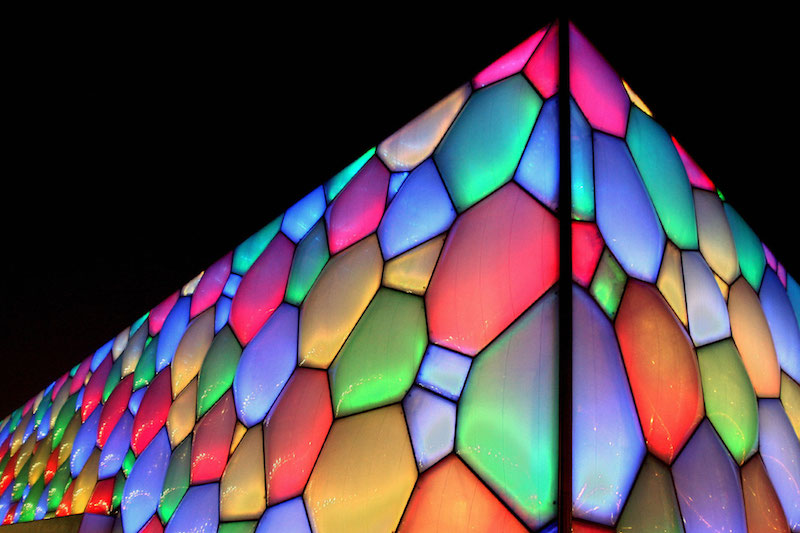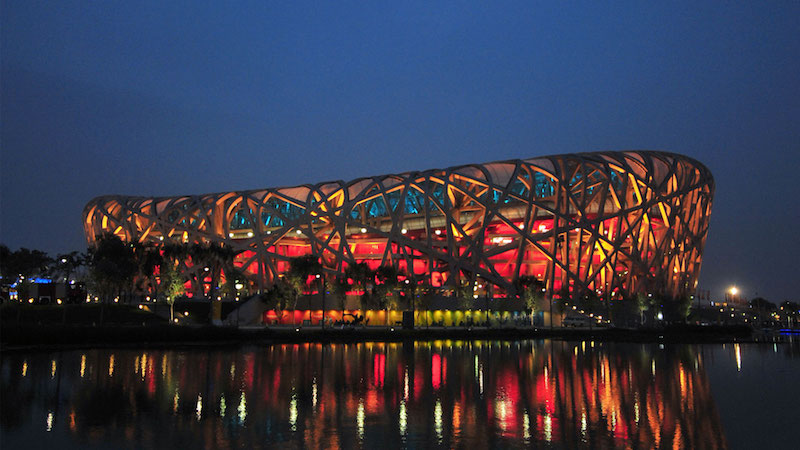Ethylene Tetrafluoroethylene
A name that’s difficult to say but hard to forget, at least among those within the build world who have worked on projects using the versatile material. It’s much easier to just go with the more mnemonic acronym “ETFE”. This little-known plastic polymer, first created in the 1930s, has suddenly become a build world staple – especially in projects like sporting venues, commercial outlets, educational buildings, resorts, transportation hubs, and other high visibility public arenas.
A peel back of this film quickly reveals why: at just 1% the weight of glass, ETFE seems tailor-made for almost any dramatic, translucent facade a designer can dream of. The material’s light weight also makes it a favorite among general contractors who can use significantly less steel and foundation materials for support. To date, there are nearly 60 significant structures in the world that feature ETFE, and plenty more on the horizon.
Two remarkable examples, the Beijing National Aquatics Centre (also known as The Water Cube) and Beijing National Stadium, vibrantly put ETFE on high definition television screens worldwide at the 2008 Summer Olympics. This mainstream moment on sports’ biggest stage held design fans captive with wonder, and more stunning structures began to feature the versatile building agent.
A longtime design/build firm specializing in membrane structures, Birdair, served as specialty contractor for the steel and ETFE film installed on a project that took home the 2015 AIA Excelsior Award for Public Architecture. Alongside project partner FTL Design Engineering, Birdair’s ETFE installation capped off the dramatic Empire City Casino Porte Cochere located in Yonkers, NY. The versatility of the material is not lost on Birdair’s part.
“ETFE film is very popular right now,” explains Michele Roth, Business Development Manager at Birdair. “It’s been in use since the late ‘80s but in the last five years or so, the product has just exploded here in the States.”
As time has passed, even more ETFE projects have been erected, shining multi-colored spotlights on increasingly ambitious projects. But as colorful as the future looks for ETFE, its outlook did not always shine so brightly.

Origins
Much like light emitting diodes (LED), enriched baby food, and even portable cordless vacuums, ETFE (carrying brand names like Tefzel® and Hostaflon®) can trace its origins to trans-atmospheric travel, having initially been developed by DuPont as an aeronautical insulation material. In fact, ETFE is still used in some aeronautical wiring capacities, although it is not as common in comparison to the material’s bigger brother, Polytetrafluoroethylene (PTFE). Or as most people probably know it, Teflon® – another DuPont creation.
One of the main reasons Teflon ascended into the rarified air of everyday notoriety, while ETFE initially failed to launch, was due to a difference in heat-resistance. ETFE’s melting point of 267˚C tipped the scales in favor of PTFE’s more reliable 327˚C melting point in regards to wire harness applications. That led to a host of more common implementations, such as in frying pans, which brought Teflon into the world consciousness as a household name. ETFE, meanwhile, went in a very different direction.
BY THE NUMBERS
1% the weight of glass
24%-70% cheaper to install than glass
Transmits up to 95 percent of natural light
Can be stretched to 3 times its length before losing elasticity
Has a lifespan of 30/35+ years
100% recyclable
Capabilities
The potential benefits ETFE offers as a building material start with the strength to hold up to 400 times its weight. The film can also be stretched up to three times its length before losing elasticity, and is clear enough to allow 95% of natural light to pass through. At a mere 1% the weight of glass, the material is 24-70% cheaper to install while providing many of the same attributes as its nearly ubiquitous silicon-based alternative. The structurally resistant nonstick compound also keeps itself clean, with a usability lifespan of 35 years or more – imagine the cost savings on cleaning and maintenance alone.
As a contractor, the material’s wide variety of capabilities is not lost on Birdair. “There are a lot of really great benefits,” explains Michele Roth. “One of the benefits of fabric membrane – You can span longer distances with ETFE without the need of structural steel support than you would with conventional building products,” she expounds. The differences between the film and glass also drive interest for other uses for ETFE. “The government is really interested in this product in terms of blast resistance in comparison to glass.” Michele sees further validity in comparing the two materials. “Due to its clarity and its lightweight nature, ETFE is most often used as an alternative to a glass system helping to reduce costs with the use of less structural support systems. However, you can also get ETFE in various colors or different printed frit patterns. Even more so, with the use of digital printing you can customize just about anything onto the ETFE film. White ETFE film is excellent when you’re using LED lights, really helping to accentuate the projected colors onto the film.”
Even more substantial, ETFE is also 100% recyclable and can be melted down to produce more of the material, making it truly sustainable for environmentally conscious build projects. Perhaps the most impressive of all ETFE properties is the material’s insulation potential. Many ETFE roofs are layered, with air passing between one, two, or three sheets of the polymer, depending on the need. This not only allows the structure to retain heat in the winter and stay cooler in the summer, an ETFE roof can also achieve a thermal value superior to glazed roofing, as low as 0.1W/m2k. These values can be increased or decreased depending on the addition of more layers and specialty coatings.
Goodbye to Glass? What’s Next?
From current projects like the U.S. Bank Stadium in Minneapolis and the Mercedes Benz Stadium built in Atlanta, the beginnings of a future with more grandiose and technologically savvy ETFE designs is taking form. Given that the material has such a vast array of strengths, it would seem that despite having ETFE as a resource for the past 30-plus years, the build environment may just be scratching the surface when it comes to the possibilities of what can be achieved.
After all, the first endeavor to bring ETFE into the mainstream was the Eden Project in 2001, a multi-biomed rainforest in Cornwall, UK, which turned a former mining pit into a horticultural utopia housing plants from diverse climates. While it sounds odd to create a preserve by wrapping it in plastic, the project’s continued success today could foreshadow the possibility of sustaining life in increasingly harsher environments., whether it be on Earth, the Moon, Mars, or even beyond. Maybe someday. For now, the material’s eco-friendly benefits open up a universe of doors for green building projects. Soon, ETFE may even join brick, cement, glass, steel, and wood in the pantheon of building material staples. It has certainly been making a strong case of late in some very big ways.
“Even more substantial, ETFE is also 100% recyclable and can be melted down to produce more of the material, making it truly sustainable for environmentally conscious build projects.”
More from Author
Mike Landers | Aug 2, 2017
Are visual ergonomics the new key to project delivery?
An Australian Home Theater Company is out to prove that the easier you can see it, the easier you can sell it.







